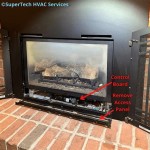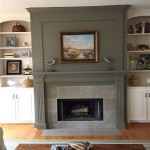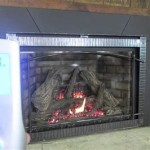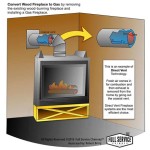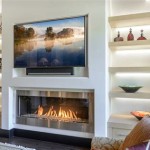Trim for Fireplace Opening: Aesthetics, Functionality, and Installation
The fireplace, traditionally a focal point of the home, offers warmth, ambiance, and a sense of comfort. Beyond its functional role in providing heat, the fireplace significantly contributes to the room's overall aesthetic. A key element in enhancing this aesthetic is the trim surrounding the fireplace opening. Fireplace trim, also known as a surround or facing, serves both a decorative and practical purpose, framing the firebox and integrating it seamlessly into the room's design. The selection of appropriate trim involves careful consideration of materials, styles, installation methods, and adherence to safety guidelines.
The purpose of this article is to present a comprehensive overview of fireplace opening trim, covering various aspects from material options and design considerations to installation techniques and safety precautions. It aims to provide homeowners and builders with the information needed to make informed decisions regarding fireplace trim selection and installation, ensuring both aesthetic appeal and functional integrity.
Material Options for Fireplace Trim
The choice of material for fireplace trim is a critical decision, influencing not only the visual appearance but also the durability, maintenance requirements, and overall cost. Several materials are commonly used, each possessing unique characteristics that make them suitable for different applications and design preferences.
Wood remains a popular choice for its versatility and warmth. Wood trim can be crafted from various species, including hardwoods like oak, maple, and cherry, as well as softwoods like pine and fir. The natural grain patterns and ability to be stained or painted in a wide range of colors make wood a highly adaptable option. However, wood is susceptible to heat damage and requires a significant buffer zone between the firebox and the trim itself. Proper sealing and finishing are essential to protect wood from moisture and prevent warping or cracking. It is crucial to verify that any wood trim meets local fire safety regulations.
Stone offers a more robust and fire-resistant alternative. Natural stone options include granite, marble, limestone, and slate, each exhibiting unique textures and color variations. Stone trim provides a sense of elegance and permanence. Manufactured stone, also known as cultured stone, is a cost-effective option that mimics the look of natural stone. Stone trim is generally more expensive than wood but offers superior durability and requires less maintenance. Its non-combustible nature makes it an excellent choice for close proximity to the firebox.
Metal, such as cast iron, steel, or brass, provides a sleek and modern aesthetic. Metal trim is highly durable, fire-resistant, and can be shaped into intricate designs. Cast iron offers a classic, traditional look, while stainless steel provides a contemporary, industrial feel. Brass trim adds a touch of warmth and elegance. Metal trim can be powder-coated or painted to match the surrounding decor. While metal trim is resistant to heat, it can become hot to the touch, so caution is advised, especially around fireplaces used frequently. The thermal expansion and contraction of metal must also be considered during installation.
Tile presents a diverse range of design possibilities. Ceramic, porcelain, and mosaic tiles can be used to create unique and visually striking fireplace surrounds. Tile is heat-resistant, easy to clean, and available in a vast array of colors, patterns, and sizes. Tile trim can be installed in various configurations, from simple borders to intricate murals. Grout selection is important, as it should be heat-resistant and easy to maintain. Tile is a versatile option that can complement various architectural styles, from traditional to contemporary.
MDF (Medium-Density Fiberboard) is a cost-effective alternative to solid wood, offering a smooth, paintable surface. While MDF is more dimensionally stable than solid wood, it is not as resistant to moisture and should not be used in areas prone to dampness. MDF trim is typically used in conjunction with a fire-resistant material, such as tile or stone, near the firebox. It is essential to prime and paint MDF trim to protect it from moisture and prevent swelling. MDF is a suitable option for decorative trim in areas away from the immediate heat of the fireplace.
Design Considerations for Fireplace Trim
Beyond material selection, the design of the fireplace trim plays a crucial role in complementing the room's style and enhancing the overall aesthetic. Several design aspects should be considered to achieve a cohesive and visually appealing result.
Style and Proportion: The style of the fireplace trim should align with the architectural style of the home and the existing decor. Traditional homes often feature ornate wood trim with intricate carvings or stone surrounds with classic detailing. Contemporary homes may opt for sleek, minimalist designs with clean lines and simple shapes. The proportion of the trim should be carefully considered to ensure it is in scale with the fireplace opening and the surrounding wall. Overly large trim can overwhelm the space, while trim that is too small may appear insignificant.
Color and Finish: The color and finish of the fireplace trim should complement the room's color palette and create a cohesive look. Neutral colors, such as white, cream, and gray, are versatile choices that can blend seamlessly with various decor styles. Bold colors can be used to create a focal point and add visual interest. The finish of the trim can also significantly impact its appearance. A glossy finish can reflect light and create a more formal look, while a matte finish provides a more subtle and understated aesthetic. For wood trim, staining allows the natural grain patterns to show through, while painting provides a consistent and uniform color.
Mantel Integration: The mantel, a shelf above the fireplace opening, is often integrated with the trim to create a unified design. The mantel should be proportional to the fireplace opening and the surrounding wall. It can be made from the same material as the trim or from a contrasting material to add visual interest. The mantel can be used to display decorative items, such as artwork, vases, and photographs. The style of the mantel should complement the style of the trim and the overall decor of the room.
Hearth Considerations: The hearth, the non-combustible area in front of the fireplace opening, should be integrated with the trim to create a seamless transition. The hearth can be made from the same material as the trim or from a contrasting material to define the space. The size of the hearth should be adequate to protect the surrounding floor from sparks and embers. The shape of the hearth can be rectangular, square, or curved, depending on the design of the fireplace and the overall aesthetic of the room.
Customization and Detailing: Customization options allow for unique and personalized fireplace trim designs. Intricate carvings, moldings, and inlays can add character and sophistication to the trim. Custom details, such as decorative tiles or metal accents, can further enhance the visual appeal. Working with a skilled carpenter or designer can help homeowners create a truly unique and personalized fireplace surround that reflects their individual style and preferences.
Installation Techniques and Safety Precautions
Proper installation of fireplace trim is crucial for both aesthetic appeal and safety. Incorrect installation can lead to structural issues, heat damage, and potential fire hazards. Adhering to manufacturer instructions and local building codes is essential.
Preparation: Before beginning the installation process, it is important to prepare the area properly. This includes cleaning the surrounding wall surface, ensuring it is level and free of debris. Any existing trim or facing should be carefully removed. Measurements should be taken accurately to ensure the new trim fits properly. A detailed plan should be developed, outlining the steps involved in the installation process.
Framing and Support: Depending on the weight and material of the trim, additional framing or support may be required. Wood framing can be used to provide a solid base for attaching the trim. Metal brackets or anchors can be used to secure heavy stone or metal trim to the wall. It is important to ensure the framing is strong enough to support the weight of the trim and that it is properly attached to the wall studs.
Adhesive and Fasteners: The choice of adhesive and fasteners will depend on the material of the trim and the type of wall surface. Construction adhesive is commonly used to attach wood trim to drywall or plaster. Mortar is used to adhere stone or tile trim to masonry surfaces. Screws, nails, or bolts can be used to provide additional support and secure the trim in place. It is important to use fasteners that are compatible with the material of the trim and the wall surface.
Clearances and Fire Safety: Maintaining proper clearances between the fireplace opening and combustible materials is crucial for fire safety. Local building codes specify minimum clearances that must be adhered to. Non-combustible materials, such as stone, tile, or metal, should be used in close proximity to the firebox. Wood trim should be installed with adequate spacing to prevent heat damage. It is important to consult with a qualified building inspector or fire safety professional to ensure the installation meets all applicable codes and regulations.
Finishing and Sealing: Once the trim is installed, it should be properly finished and sealed to protect it from moisture and heat damage. Wood trim should be primed and painted or stained and sealed. Stone or tile trim should be sealed to prevent staining and water damage. Metal trim should be coated with a protective finish to prevent rust or corrosion. Caulking can be used to seal any gaps between the trim and the wall surface, creating a clean and professional look.
Professional Installation: For complex installations or when dealing with gas or electric fireplaces, it is advisable to hire a qualified professional. A professional installer has the expertise and experience to ensure the trim is installed correctly and safely. They can also provide advice on material selection, design considerations, and compliance with local building codes. Professional installation can provide peace of mind and ensure the fireplace trim will last for years to come.

Fireplace Trim Kit

Diy Faux Plaster Fireplace Surround Chelsey Freng

Fireplace Trim

53 Best Fireplace Mantel Designs To Ignite Your Creativity Home Remodel Marble Surround

How To Choose And Install Fireplace Trim Moulding The Handyman S Daughter

Unfinished 48 Inch X 41 Wood Fireplace Mantel Surround Kit With Shelf And Trim Klamath From Mantels Direct Poplar Wooden Chimney Com
Fireplace Mantel Clearances Jlc

Simplifire 30 In Built Fireplace With Surround Trim Kit Sf Bi30 Eb Mantels Direct

Help Edging Trim For Fireplace Heart Hometalk

Recent Work Vaughans Of Maidstone
Related Posts

